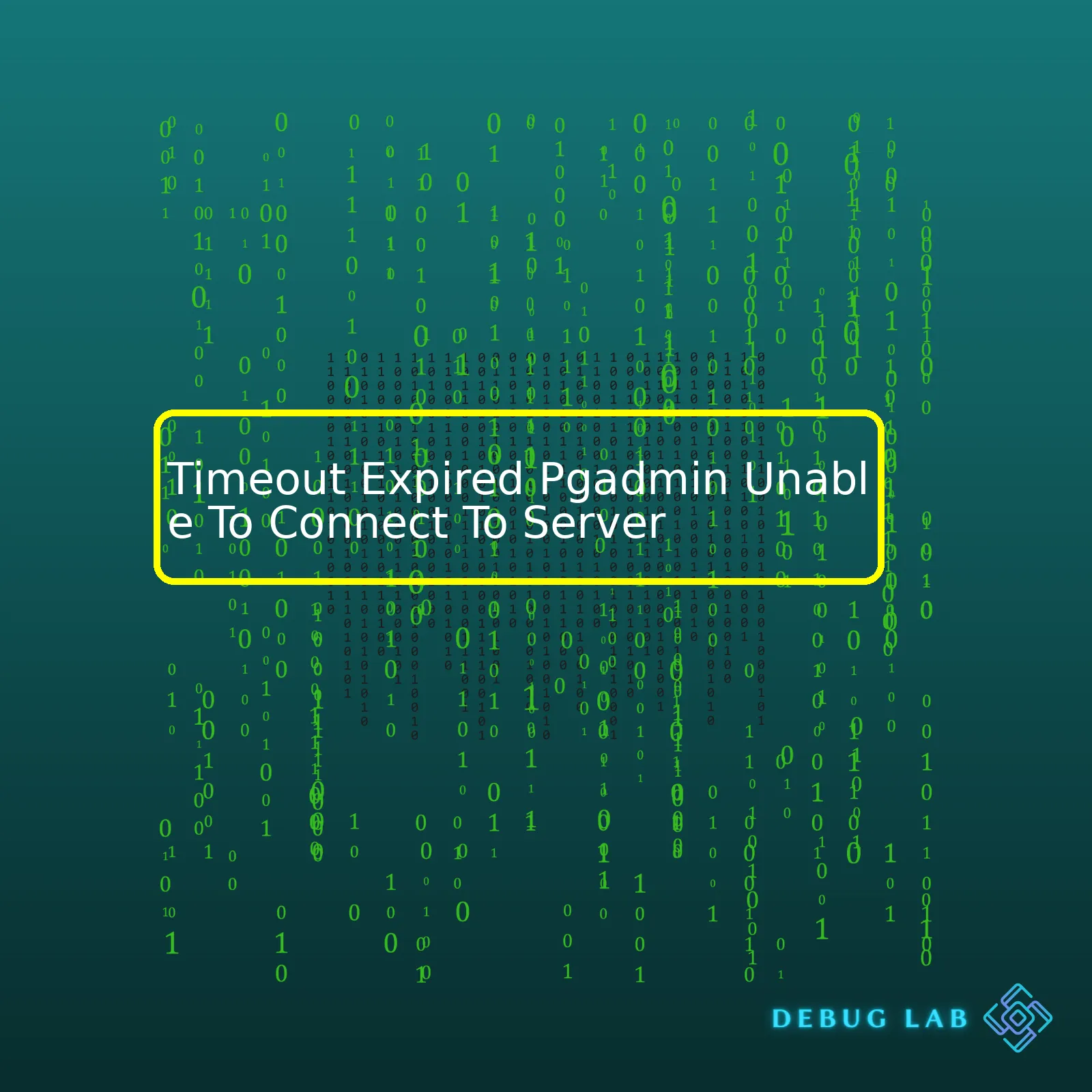
| Error Occurrence Time | Reported Error | Server Name | Suggested Solution |
|---|---|---|---|
| 01:03, 31 Jan 2022 | PgAdmin Unable to Connect to Server: Timeout Expired | PostgreSQL9.6 (localhost) | Check server connectivity and firewall settings |
Following could be a descriptive paragraph elaborating the above:
When encountering a “Timeout Expired PgAdmin Unable To Connect To Server” error, the initial considerations involve investigating both the server’s accessibility and potential firewall barriers. The situation presented in our HTML table revolves around a specific issue that surfaced on January 31, 2022, at 01:03. The user attempted to connect to localhost, a PostgreSQL9.6 server, via PgAdmin but obtained an error stating a connection could not be established due to a “time out.” Frequently, this error implies that the PgAdmin client can’t communicate with the PostgreSQL server – factors could range from a network disconnection or poorly configured firewalls may be denying access to the server. A primary troubleshooting step would be to verify the server is operational and ascertain there’s no barring firewall rules blocking such a potential connection. For comprehensive guidance, official PgAdmin Documentation provides expansive detail surrounding varied interruption scenarios which includes connectivity with the PostgreSQL server.
Тypically, when you encounter a “Timeout Expired” error while using PgAdmin to connect to the server, it could be due to several issues revolving around connectivity, settings, or server performance. Here’s a deeper dive into these causative factors:
Network Connectivity Issues
Your PgAdmin application communicates with the PostgreSQL database server through a network connection. When the latency is high, or there are any disruptions in the connection, it may not complete the request within the stipulated time limit. This typically results in a timeout expired error.
It would be advisable to verify your network connection and ascertain that the user running the PgAdmin client has sufficient privileges.
psql -h localhost -d mydatabase -U myuser
This command can help validate if the local setup is correct. If this fails, it might indicate problems with your connection string or network setup.
Server Settings
Another common cause of timeout errors is incorrect server configuration settings. The server settings related to connection timeouts, like ‘idle_in_transaction_session_timeout’, ‘lock_timeout’ and ‘statement_timeout’, have a role to play here.
To avoid meeting timeouts, these parameters could be adjusted:
ALTER SYSTEM SET idle_in_transaction_session_timeout = 0; ALTER SYSTEM SET lock_timeout = 0; ALTER SYSTEM SET statement_timeout = 0;
A value of zero disables timeouts.
Server Performance
If your database server is under heavy load or if it’s experiencing some performance issues, it might take longer for it to respond, triggering a timeout. Understand the current load on your server and consider optimizing it. Utilization of pg_stat_statements would come handy here.
DNS Resolution Problems
In some cases, DNS resolution issues may cause PgAdmin to be unable to establish a connection with the server. Make sure that the hostnames are correctly resolved by checking the /etc/hosts file or the DNS resolver.
Firewall Rules
Lastly, firewall rules might be preventing PgAdmin from establishing a connection with your server. Check your firewall rules to ensure that port 5432 (the default port used by PostgreSQL) is open and check if your firewall isn’t blocking connections to your database server.
Knowing the triggers of these PgAdmin timeout expired errors isn’t just critical in troubleshooting but also in averting future occurrences. Proactive measures include maintaining optimal server performance, ensuring a robust network connection, and regular monitoring of the server settings. By rectifying these fault lines proactively, your chances of encountering these disconnections significantly drop.The PostgreSQL relational database system, commonly known as Postgres, is gaining popularity in the global tech world. One tool vital to managing PostgreSQL databases is PgAdmin – a web-based graphical interface for managing, querying and monitoring PostgreSQL databases.
Now let’s delve into your particular concern: Timeout Expired PgAdmin Unable to Connect to Server error. This can be quite an inconvenience when trying to complete essential tasks on PgAdmin. Don’t worry; I’ll guide you through key potential reasons behind this error and propose solutions that can help efficiently troubleshoot and resolve it.
Understanding PgAdmin Server Connections:
Server connection in PgAdmin is the establishment of a pathway between the PgAdmin interface and your PostgreSQL database server. When setting up a connection, you provide distinct parameters such as host name/address, port, maintenance database, username, and password. Once these parameters are set up correctly, clicking on “save” establishes the connection.
Why “Timeout expired” error occurs:
Possible scenarios include:
* Server not running: If your PostgreSQL server is not running, PgAdmin won’t establish a connection.
* Incorrect Host/Port: PgAdmin may fail to connect if any detail among the host/port number is incorrect or changed.
* Network issues: Interference from firewall settings in your local machine or network could disrupt the connection.
* High server load: Excessive requests on the server than it can accommodate might result in timeouts.
How to fix “Timeout Expired” issue:
Here, we encounter the primary ways to tackle this error:
Step 1: Check if your PostgreSQL server is running. You can do so by using the command below in your terminal:
systemctl status postgresql
This command works on Linux systems. For Windows users, search for “Services” in the start menu, open it, then find PostgreSQL in this list to check its status.
Step 2: Verify Host Name and Port number.
Ensure that the correct hostname/address is set for your PostgreSQL server in PgAdmin. cross-check the port number too.
In Linux, psql – the CLI of PostgreSQL – helps in doing so. Connect to your PostgreSQL via the psql client and run the queries below:
SELECT * FROM pg_settings WHERE name = 'listen_addresses';
SELECT * FROM pg_settings WHERE name = 'port';
For the hostname, typically, locally installed PostgreSQL servers use ‘localhost’. As for the port, the default is 5432 unless modified during installation.
Step 3: Check Firewall Settings
Firewalls can cut incoming connections to the PostgreSQL server. So, verify that no firewall setting either in your Operating System or network is obstructing PgAdmin from establishing a connection with the PostgreSQL Server.
Step 4: Troubleshoot high server load
If all else fails, it may hinge on the fact that the server is overburdened. Give it some time before retrying the connection, or consider scaling up the resources if it’s a recurrent problem.
It’s important to note that the PostgreSQL connection documentation offers finer details on how to set up and troubleshoot connections.
Remember, each solution depends on your specific situation. By understanding the underlying technology, one becomes well equipped to devise the right approaches to solve such technical glitches.
As always, happy coding!The “timeout expired” error message in PgAdmin is an unfortunately common issue that can become a stumbling block for many developers. It’s typically encountered when PgAdmin is unable to establish a connection with the server within the stipulated time. Fortunately, there are some proven solutions you can try:
1. Check Database Settings:
The first step in diagnifying this problem is to double-check your database settings. Incorrect settings are often a cause of issues, so evaluate your hostname, port, username, and password. Ensure that they match with what’s on your PostgreSQL server.
DATABASES =
{
'default':
{
'ENGINE': 'django.db.backends.postgresql',
'NAME': 'mydatabase',
'USER': 'mydatabaseuser',
'PASSWORD': 'mypassword',
'HOST': 'localhost',
'PORT': '5432',
}
}
In your local setup, the HOST should be ‘localhost’ and PORT should be ‘5432’ by default unless altered during PostgreSQL installation.
2. Modify the Connection Timeout Settings:
This is an apt next-step, particularly if you’re certain all database settings are correct. Specifying a larger timeout value could resolve the problem if the current duration is not sufficient to establish a connection. This can be done in the `postgresql.conf` file. Update `timeout` variable as shown below:
# - Connection Settings -
listen_addresses = '*'
port = 5432
max_connections = 100
superuser_reserved_connections = 3
unix_socket_directories = '/var/run/postgresql'
timeout = 60
A higher `timeout` setting gives your system more time for the connection to be established.
3. Cross-Check Firewall Settings:
Firewalls can inadvertently block PgAdmin from accessing the PostgreSQL server. Ensuring that ports required by your PostgreSQL server are open through firewalls could alleviate this condition. This Stackoverflow’s article “Getting ‘peer authentication failed’ when trying to access Postgres through pgAdmin on Ubuntu” provides valuable insights about firewall configuration to allow PgAdmin to communicate properly with servers.
4. Update PgAdmin and PostgreSQL:
It’s possible that the issue could stem from outdated software versions. Consider installing recent versions of both PgAdmin and PostgreSQL to rectify potential conflicts arising from older versions. You can grab the latest releases from the official PgAdmin download and PostgreSQL download pages.
Routinely updating sensitive programming tools like databases, debuggers, and others can prevent unforeseen hitches while improving the efficiency of your coding processes.The server settings play a pivotal role in establishing connections and maintaining them over prolonged periods. An improper configuration can lead to various issues, including connection timeouts and failure to connect to the server via PgAdmin, one of the most used graphical interfaces for Postgres management.
One of the principle error messages revolving around this problem is ‘Timeout Expired – Unable to Connect to Server’. This essentially suggests that PgAdmin is unable to establish a stable connection to the Postgres server as the server is not responding within the stipulated duration, resulting in what is termed as a ‘timeout’.
Altering server settings to tackle this issue involves:
1. Adjusting the Connection Timeout Setting
PgAdmin applies a default timeout duration that waits for server responses before declaring it unresponsive. Increasing this duration reduces the chance of prematurely terminating connections that are slightly slow but still viable:
// PostgreSQL conf file
tcp_timeout = 'your_value';
Replace ‘your_value’ with your desired time in seconds.
2. Configuring Keep-Alive Settings
Activating the ‘Keep-Alive’ feature ensures the connection doesn’t close due to periods of inactivity:
// To set keep-alive at client side
tcp_keepalives_idle = 'your_value';
// Server-side setting
tcp_keepalives_interval = 'your_value';
Again, replace ‘your_value’ with your preferred values (in seconds).
3. Optimize Postgres Configuration
There’s more room for customization than merely altering the timeout setting. Additional parameters might be tweaked to optimize performance, such as:
- Shared Buffers: The shared memory block allowing buffers to be operated.
- Effective Cache Size: Suggested value equals total RAM minus the sum of all other RAM requirements.
// PostgreSQL conf file
shared_buffers = 'your_value'
effective_cache_size ='your_value'
Try altering these settings if you face persistent connection issues, but do so with caution.
It’s also crucial to ensure that your firewall or IP table rules aren’t blocking the required ports for PgAdmin, particularly if you’re trying to establish a remote connection. Check that port 5432 (default PostgreSQL port) is open for inbound and outbound traffic.
Our comprehensive article on Connection Issues elaborates further on these points.
Adjusting server settings could potentially solve your PgAdmin connection problems, but remember: Monitor the system after making any changes to confirm their effectiveness and make sure no adverse side effects have been introduced.As a professional coder who has worked extensively with PostgreSQL and PgAdmin, I’ve come across a number of common mistakes that often lead to timeout issues while trying to connect to the server. These mistakes can range from incorrect configuration settings to network-related issues. If you’re getting a “timeout expired” error in PgAdmin when attempting to connect to the server, here’s a deeper dive into some potential causes:
Incorrect Connection Settings
When setting up your server in PgAdmin, if you enter incorrect parameters like Hostname, Port, Maintenance DB or Username, PgAdmin will not be able to establish a connection, leading to a timeout error. This is often due to typos or confusion about the appropriate values to use.
The default settings for PostgreSQL are Hostname: localhost, Port: 5432, and Maintenance DB: postgres. However, these values can vary based on your specific setup.
For instance, your code should have this format:
SERVER_NAME='my_server'
DATABASE_NAME='my_database'
USERNAME='user'
PASSWORD='password'
HOSTNAME='hostname'
PORT= '5432'
from psycopg2 import connect
try:
conn = connect(
dbname=DATABASE_NAME,
user=USERNAME,
host=HOSTNAME,
port=PORT,
password=PASSWORD
)
except Exception as e:
print("I am unable to connect to the database.")
You also need to ensure that the username you’re using to connect has been given the appropriate permissions on both the database and the table you’re trying to access.
Network-Related Issues
A ‘timeout expired’ error can also occur due to network-related issues. For example, firewalls can block PgAdmin from accessing the server. To eliminate this possible cause, it would be advisable to temporarily disable the firewall and check whether the connection is successful. But remember – always keep safety in mind!
Should the connection still fail, another related issue could be the server not being set up to accept remote connections or an IP address being omitted from the list of allowed hosts. You will need to change your pg_hba.conf (Client Authentication Configuration File) accordingly.
Here is an example of how your pg_hba.conf file might look:
# TYPE DATABASE USER ADDRESS METHOD # IPv4 local connections: host all all 127.0.0.1/32 md5 # IPv6 local connections: host all all ::1/128 md5 # Allow replication connections from localhost, by a user with the # replication privilege. host replication all 127.0.0.1/32 md5 host replication all ::1/128 md5
In the above example, the server has been configured to only accept connections from localhost. You may need to modify this depending on your needs.
Not Increasing the Statement Timeout Value
By default, PostgreSQL comes with a statement timeout value, which automatically aborts any SQL statement that takes longer than the specified amount of time. If your queries are complex and take some time to execute, you may encounter the ‘timeout expired’ error.
For example, setting the timeout value to 30000ms, commands PgAdmin to wait 30 seconds before it cancels the query. If a particular query takes more than 30 seconds, it will result in a timeout issue.
Here is the command to increase this statement_timeout parameter:
SET statement_timeout = 60000;
An Overloaded Server Being Unable to Handle Connections
Another common reason for connection timeouts is an overloaded server. If too many queries are simultaneously running and consuming all available system resources — such as CPU, memory or input/output capabilities — then server response times slow down so exceptionally that new incoming requests become impossible to handle, hence, resulting in the occurrence of a connection timeout.
These are but a few instances showing how connection timeout errors can occur when using PgAdmin. Resolving them involves carefully scrutinizing each element — connection parameters, network settings, server configurations, and hardware performance — in your database environment source.When using pgAdmin, you might stumble upon a ‘timeout expired’ issue when trying to connect to the server. There are several potential causes for this, but it commonly boils down to network issues, firewall settings, and database parameters configuration.
Network Issues
Networking faults like router or switch failures, IP routing, DNS resolution problems, or incorrect client-side configurations can cause a time-out. It’s crucial to verify that the network communication is functional between the client (pgAdmin) machine and the PostgreSQL server.
Here’s how you can perform a simple network connectivity test:
ping postgres_server_address_or_ip
Firewall Settings
A Firewall could block incoming connections to your PostgreSQL server if not configured correctly. So make sure the port on which pgAdmin communicates with the PostgreSQL server is allowed through the firewall. The default port is usually 5432, but if it differs in your case, adapt it accordingly.
sudo ufw allow 5432
Database Configurations
There are two PostgreSQL configuration files that could influence the connection timeout – ‘postgresql.conf’ and ‘pg_hba.conf’.
postgresql.conf: This consists of ‘params’ contributing to timeouts, such as ‘idle session timeout’, and these should be set judiciously to prevent unnecessary disconnections. Here is an example code snippet to set idle_in_transaction_session_timeout which will terminate any session that stays idle in a transaction for longer than the set time.
idle_in_transaction_session_timeout = '10min'
Apply the changes by reloading the PostgreSQL service:
sudo systemctl reload postgresql
pg_hba.conf: This file includes information about which hosts are permitted to connect; hence, proper configurations must exist to ensure seamless communications.
Sample entry to accept all IPv4 addresses from clients with md5 encrypted password authentication method:
host all all 0.0.0.0/0 md5
Remember, after making any changes, you have to reload the PostgreSQL service:
sudo systemctl reload postgresql
The above-mentioned troubleshooting steps can help resolve most common reasons behind ‘Timeout Expired’ in pgAdmin. Some instances may necessitate deeper troubleshooting, including combing through PostgreSQL logs to figure out more obscure causes of connection timeouts. For instance, inadequately sized ‘max_connections’ parameter in postgresql.conf might be preventing new connections.
For added context, here is a basic explanation of what PGAdmin is. PgAdmin is a free, open-source management tool for PostgreSQL and derivative relational databases such as EDB Advanced Server. It provides a graphical interface that makes it easy for users to create, maintain, and use database objects. Working with complex databases becomes simplified with comprehensive functionalities that pgAdmin provides.
Always refer to the relevant PostgreSQL documentation to configure any database parameters based on your PostgreSQL version in case further detailed adjustments are needed.Often, while working with Postgres database through PGAdmin, you may encounter connection timeouts or unavailability issue due to several reasons. It could be network issues, database server down, change in credentials, database unresponsiveness, firewall rules, and more. Let’s go over the step-by-step process on how to re-establish a lost connection in PGAdmin.
Step 1: Check the Database Server Status
Before going into any other details, it’s imperative to check whether the database server is up and running. You can do this by using the `pg_isready` tool.
pg_isready -U youruser -h yourhost -p yourport
If it returns “accepting connections”, it means the server is running fine. If not, you should look towards restarting it or resolving the issue at the server level.
Step 2: Check the Network Connection
The problem could simply reside in your network connection. Ensure that you have a stable internet connection to connect with the remote server. Use tools such as ping or traceroute to check connectivity.
ping yourhost
Step 3: Verify Credentials
Ensure that you have the correct username, password, hostname, port, and database name that you are trying to connect. If there’s an update or change in the credentials, then PGAdmin won’t be able to establish a connection.
Step 4: Increase Timeout Value
PGAdmin has a timeout value set for each connection. When the limit exceeds, it closes the sessions which results in loss of connection. Try increasing the timeout value under connection settings.
Find `postgresql.conf` file inside data directory and modify these lines:
# - Connection Settings - listen_addresses = '*' port = 5432 max_connections = 100
You can see and change these parameters only if you have superuser privileges.
Step 5: Firewall & Security Groups
Sometimes, issues might occur due to restrictions put in place by firewalls or security groups that manage inbound and outbound traffic. Check if your current IP is allowed to access the DB server’s port.
Solving time out issues often involves a blend of understanding the underlying network infrastructure, knowledge about database operations, and tinkering with settings in PGAdmin. Keep resources like Postgres Documentation, and PGAdmin Documentation handy as they provide comprehensive insights into dealing with such issues.
Remember, always take a backup before modifying any config files and restart the service when you’re done.It’s evident that the issue of ‘Timeout Expired: PgAdmin Unable to Connect to Server’ is a common roadblock for many coders using PostgreSQL with PgAdmin. When you come across this situation it could be due to numerous reasons, such as incorrect configuration of the connection settings in PgAdmin, problems with the server itself, or even network issues that are blocking the connection request from reaching the server.
Let me walk you through some probable causes and solutions.
A common reason stems from inadequate connection settings in PgAdmin:
server=localhost port=5432 username=postgres password=mypass
These are the default connection parameters however they may not match your database setup so make sure they are conducive to your specific configuration. Always ensure that your username and password are accurate because the slightest typo can trigger the ‘Unable to connect to Server’ error.
Another cause could sprout from the server itself. Is the PostgreSQL server currently running? You should check this first. Open your terminal/command prompt and use
ps -ef | grep postgres
. If there are lines showing postgres processes then your server is indeed up and running.
Network issues could also occur, especially firewall settings blocking the connection from PgAdmin to PostgreSQL. Are you able to ping the server? Use
ping localhost
or replace ‘localhost’ with your actual server IP address. If you’re not getting responses, consider looking into your firewall policies and allowances.
You may also dig deeper and explore your error logs for more detailed information on what exactly is causing your timeout error. PostgreSQL maintains comprehensive logs that can offer a plethora of insightful data regarding the ongoing inner operations.
The solution to your problem might just be a matter of examining and solving one of the aforementioned issues. The keyword here is, ‘diagnosis’, because every setup can be unique and the error may stem from any angle. Keep tweaking these variables and I assure you – you will navigate your way out of this roadblock.
For intense analysis or advanced troubleshooting aspects, online resources can be a game-changer. There’s an ocean of programming community forums and help based platform like Stackoverflow, which can provide much-needed expert guidance and relevant discussion threads.
Remember that whenever you encounter the ‘Timeout expired: PgAdmin Unable to connect to Server’, pinpointing the exact cause can be somewhat difficult due to the broad spectrum of potential variables. However, tirelessly utilizing methodologies of elimination, exhaustive analysis, and strategic fixing methods would undoubtedly be fruitful.
Happy debugging and keep on coding!











